winter tyres SKODA OCTAVIA TOUR 2009 1.G / (1U) Owner's Manual
[x] Cancel search | Manufacturer: SKODA, Model Year: 2009, Model line: OCTAVIA TOUR, Model: SKODA OCTAVIA TOUR 2009 1.G / (1U)Pages: 226, PDF Size: 13.11 MB
Page 144 of 226
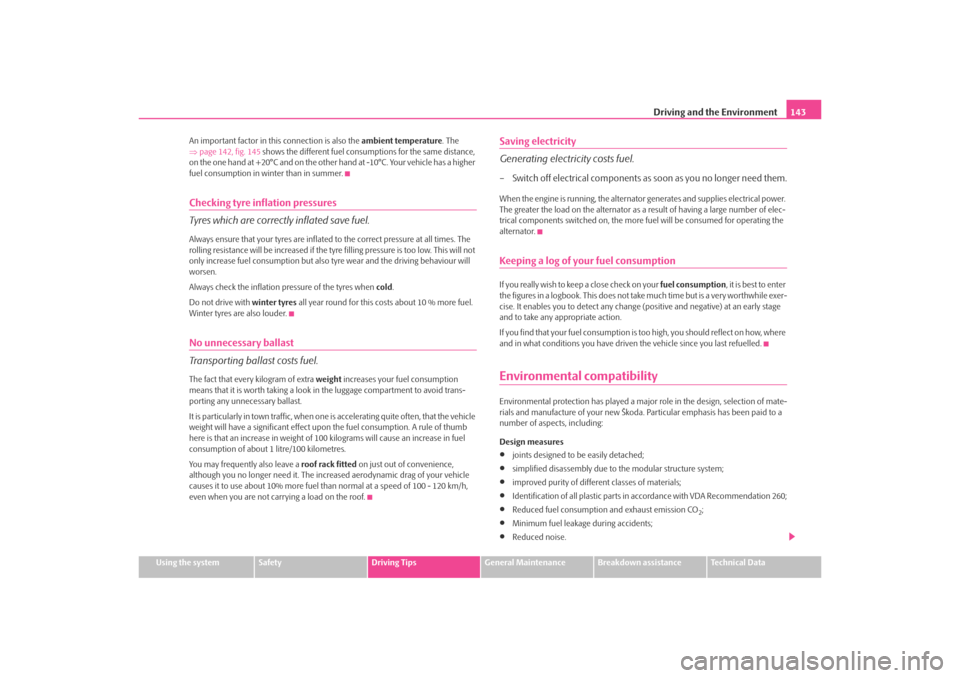
Driving and the Environment143
Using the system
Safety
Driving Tips
General Maintenance
Breakdown assistance
Technical Data
An important factor in this connection is also the
ambient temperature. The
⇒ page 142, fig. 145 shows the different fuel consum ptions for the same distance,
on the one hand at +20°C and on the other hand at -10°C. Your vehicle has a higher
fuel consumption in winter than in summer.
Checking tyre inflation pressures
Tyres which are correctly inflated save fuel.Always ensure that your tyres are inflated to the correct pressure at all times. The
rolling resistance will be increased if the tyre filling pressure is too low. This will not
only increase fuel consumption but also tyre wear and the driving behaviour will
worsen.
Always check the inflation pressure of the tyres when cold.
Do not drive with winter tyres all year round for this costs about 10 % more fuel.
Winter tyres are also louder.No unnecessary ballast
Transporting balla st costs fuel.The fact that every kilogram of extra weight increases your fuel consumption
means that it is worth taking a look in the luggage compartment to avoid trans-
porting any unnecessary ballast.
It is par ticularly i n town tra ffi c, whe n one is accelerating quite often, that the vehicle
weight will have a significant effect upon the fuel consumption. A rule of thumb
here is that an increase in weight of 100 kilograms will cause an increase in fuel
consumption of about 1 litre/100 kilometres.
You may frequently also leave a roof rack fitted on just out of convenience,
although you no longer need it. The incr eased aerodynamic drag of your vehicle
causes it to use about 10% more fuel than normal at a speed of 100 - 120 km/h,
even when you are not carr ying a load on the roof.
Saving electricity
Generating electricity costs fuel.– Switch off electrical components as soon as you no longer need them.When the engine is running, the alternator generates and supplies electrical power.
The greater the load on the alternator as a result of having a large number of elec-
trical components switched on, the more fuel will be consumed for operating the
alternator.Keeping a log of your fuel consumptionIf you really wish to keep a close check on your fuel consumption, it is best to enter
the figures in a logbook. This does not take much time but is a very worthwhile exer-
cise. It enables you to detect any change (positive and negative) at an early stage
and to take any appropriate action.
If you find that your fuel consumption is too high, you sh ould reflect on how, where
and in what conditions you have driven the vehicle since you last refuelled.Environmental compatibilityEnvironmental protection has played a majo r role in the design, selection of mate-
rials and manufacture of your new Škoda. Particular emphasis has been paid to a
number of aspects, including:
Design measures•
joints designed to be easily detached;
•
simplified disassembly due to the modular structure system;
•
improved purity of differ ent classes of materials;
•
Identification of all plastic parts in accordance with VDA Recommendation 260;
•
Reduced fuel consumption and exhaust emission CO
2;
•
Minimum fuel leakage during accidents;
•
Reduced noise.
s2ig.book Page 143 Monday, November 10, 2008 11:20 AM
Page 176 of 226
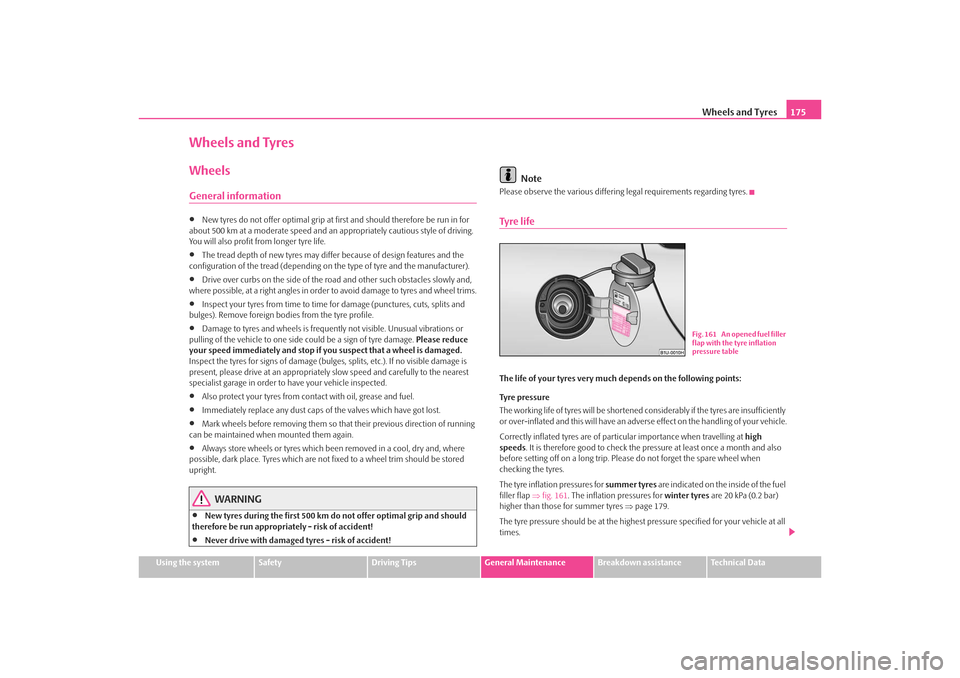
Wheels and Tyres175
Using the system
Safety
Driving Tips
General Maintenance
Breakdown assistance
Technical Data
Wheels and TyresWheelsGeneral information•
New tyres do not offer optimal grip at first and should therefore be run in for
about 500 km at a moderate speed and an appropriately cautious style of driving.
You will also profit from longer tyre life.
•
The tread depth of new tyres may differ because of design features and the
configuration of the tread (depending on the type of tyre and the manufacturer).
•
Drive over curbs on the side of the road and other such obstacles slowly and,
where possible, at a right angles in order to avoid damage to tyres and wheel trims.
•
Inspect your tyres from time to time for damage (punctures, cuts, splits and
bulges). Remove foreign bodies from the tyre profile.
•
Damage to tyres and wheels is frequent ly not visible. Unusual vibrations or
pulling of the vehicle to one side could be a sign of tyre damage. Please reduce
your speed immediately and stop if you suspect that a wheel is damaged.
Inspect the tyres for signs of damage (bulges, splits, etc.). If no visible damage is
present, please drive at an appropriatel y slow speed and carefully to the nearest
specialist garage in order to have your vehicle inspected.
•
Also protect your tyres from contact with oil, grease and fuel.
•
Immediately replace any dust caps of the valves which have got lost.
•
Mark wheels before removing them so th at their previous direction of running
can be maintained when mounted them again.
•
Always store wheels or tyres which been removed in a cool, dry and, where
possible, dark place. Tyres which are not fixed to a wheel trim should be stored
upright.
WARNING
•
New tyres during the first 500 km do not offer optimal grip and should
therefore be run appropriately - risk of accident!
•
Never drive with damaged tyres - risk of accident!
Note
Please observe the various differing legal requirements regarding tyres.Tyre lifeThe life of your tyres very much depends on the following points:
Tyre pressure
The working life of tyres will be shortened considerably if the tyres are insufficiently
or over-inflated and this will have an advers e effect on the handling of your vehicle.
Correctly inflated tyres are of partic ular importance when travelling at high
speeds . It is therefore good to check the pr essure at least once a month and also
before setting off on a long trip. Plea se do not forget the spare wheel when
checking the tyres.
The tyre inflation pressures for summer tyres are indicated on the inside of the fuel
filler flap ⇒fig. 161 . The inflation pressures for winter tyres are 20 kPa (0.2 bar)
higher than those for summer tyres ⇒page 179.
The tyre pressure should be at the highest pressure specified for your vehicle at all
times.
Fig. 161 An opened fuel filler
flap with the tyre inflation
pressure table
s2ig.book Page 175 Monday, November 10, 2008 11:20 AM
Page 179 of 226
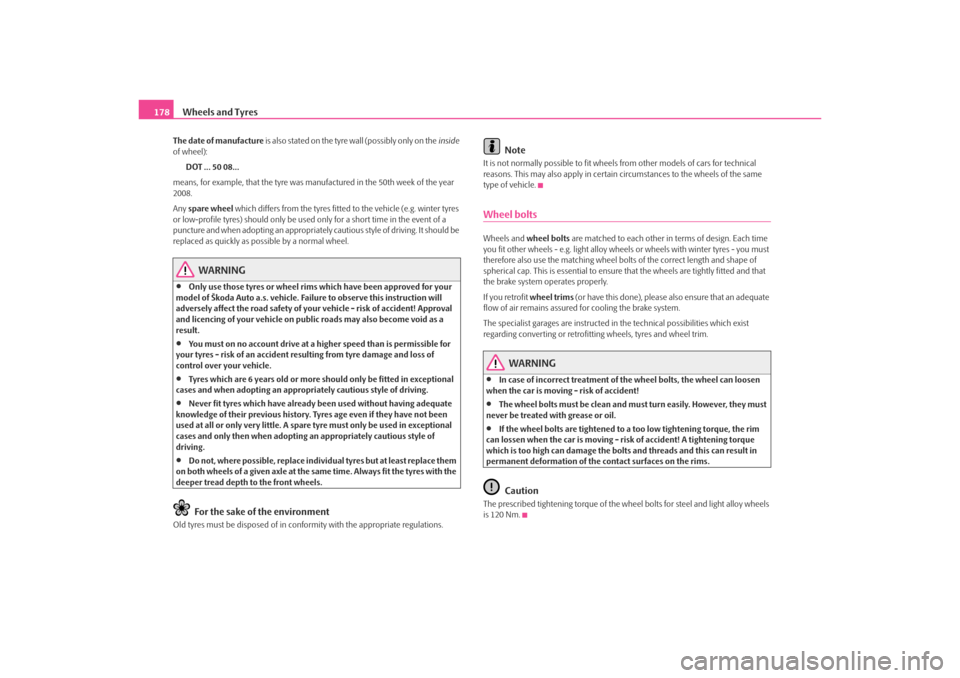
Wheels and Tyres
178The date of manufacture is a lso s tated on the tyre wal l (poss ibly o nl y on the inside
of wheel):
DOT ... 50 08...
means, for example, that the tyre was manufactured in the 50th week of the year
2008.
Any spare wheel which differs from the tyres fitted to the vehicle (e.g. winter tyres
or low-profile tyres) should only be used only for a short time in the event of a
puncture and when adopting an appropriately cautious style of driving. It should be
replaced as quickly as po ssible by a normal wheel.
WARNING
•
Only use those tyres or wheel rims which have been approved for your
model of Škoda Auto a.s. vehicle. Failure to observe this instruction will
adversely affect the road safety of your vehicle - risk of accident! Approval
and licencing of your vehicle on public roads may also become void as a
result.
•
You must on no account drive at a higher speed than is permissible for
your tyres - risk of an accident resulting from tyre damage and loss of
control over your vehicle.
•
Tyres which are 6 years old or more should only be fitted in exceptional
cases and when adopting an appropriately cautious style of driving.
•
Never fit tyres which have already been used without having adequate
knowledge of their previous history. Ty res age even if they have not been
used at all or only very little. A spare tyre must only be used in exceptional
cases and only then when adopting an appropriately cautious style of
driving.
•
Do not, where possible, replace indivi dual tyres but at least replace them
on both wheels of a given axle at the same time. Always fit the tyres with the
deeper tread depth to the front wheels.For the sake of the environment
Old tyres must be disposed of in conformity with the appropriate regulations.
Note
It is not normally possible to fit wheels from other models of cars for technical
reasons. This may also apply in certain circumstances to the wheels of the same
type of vehicle.Wheel boltsWheels and wheel bolts are matched to each other in terms of design. Each time
you fit other wheels - e.g. light alloy wheels or wheels with winter tyres - you must
therefore also use the matching wheel bolts of the correct length and shape of
spherical cap. This is essent ial to ensure that the wheels are tightly fitted and that
the brake system operates properly.
If you retrofit wheel trims (or have this done), please also ensure that an adequate
flow of air remains assured for cooling the brake system.
The specialist garages are instructed in the technical possibilities which exist
regarding converting or retrofitti ng wheels, tyres and wheel trim.
WARNING
•
In case of incorrect treatment of th e wheel bolts, the wheel can loosen
when the car is moving - risk of accident!
•
The wheel bolts must be clean and must turn easily. However, they must
never be treated with grease or oil.
•
If the wheel bolts are tightened to a too low tightening torque, the rim
can lossen when the car is moving - risk of accident! A tightening torque
which is too high can damage the bolts and threads and this can result in
permanent deformation of the contact surfaces on the rims.Caution
The prescribed tightening torque of the wh eel bolts for steel and light alloy wheels
is 120 Nm.
s2ig.book Page 178 Monday, November 10, 2008 11:20 AM
Page 180 of 226
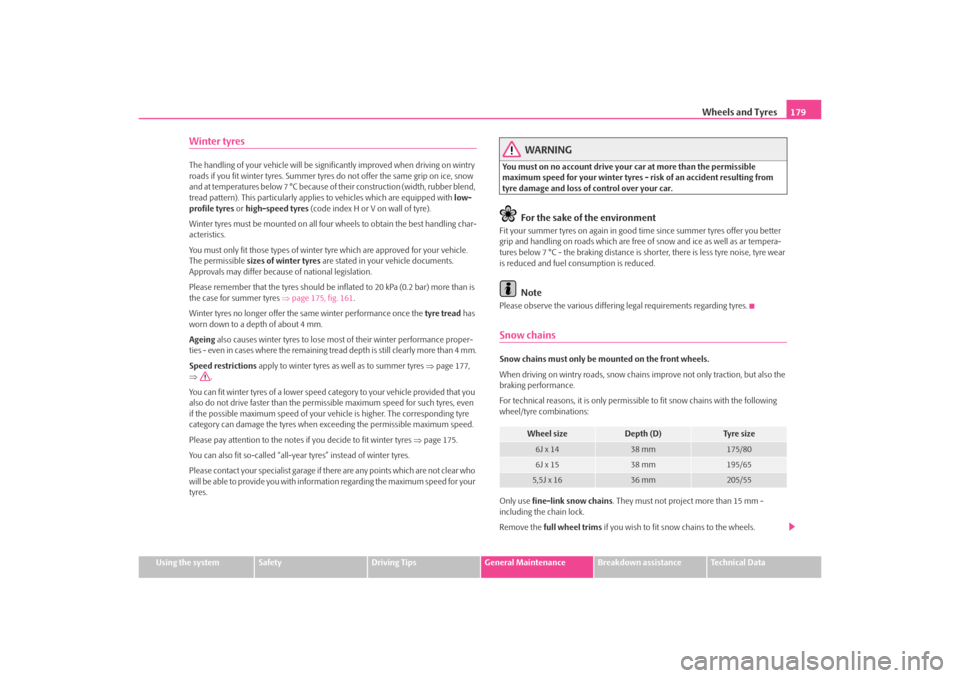
Wheels and Tyres179
Using the system
Safety
Driving Tips
General Maintenance
Breakdown assistance
Technical Data
Winter tyresThe handling of your vehicle will be significantly improved when driving on wintry
roads if you fit winter tyres. Summer tyres do not offer the same grip on ice, snow
and at temperatures below 7 °C because of their construction (width, rubber blend,
tread pattern). This partic ularly applies to vehicles which are equipped with low-
profile tyres or high-speed tyres (code index H or V on wall of tyre).
Winter tyres must be mounted on all four wheels to obtain the best handling char-
acteristics.
You must only fit those type s of winter tyre which are approved for your vehicle.
The permissible sizes of winter tyres are stated in your vehicle documents.
Approvals may differ becaus e of national legislation.
Please remember that the tyres should be in flated to 20 kPa (0.2 bar) more than is
the case for summer tyres ⇒page 175, fig. 161 .
Winter tyres no longer offer the same winter performance once the tyre tread has
worn down to a depth of about 4 mm.
Ageing also causes winter tyres to lose mo st of their winter performance proper-
ties - even in cases where the remaining tread depth is still clearly more than 4 mm.
Speed restrictions apply to winter tyres as well as to summer tyres ⇒page 177,
⇒ .
You can fit winter tyres of a lower speed ca tegory to your vehicle provided that you
also do not drive faster than the permis sible maximum speed for such tyres, even
if the possible maximum speed of your ve hicle is higher. The corresponding tyre
category can damage the tyres when exceeding the permissi ble maximum speed.
Please pay attention to the notes if you decide to fit winter tyres ⇒page 175.
You can also fit so-called “all-year tyres” instead of winter tyres.
Please contact your specialist garage if there are any points which are not clear who
will be able to provide you with information regarding the maximum speed for your
tyres.
WARNING
You must on no account drive your car at more than the permissible
maximum speed for your winter tyres - risk of an accident resulting from
tyre damage and loss of control over your car.
For the sake of the environment
Fit your summer tyres on again in good ti me since summer tyres offer you better
grip and handling on roads which are free of snow and ice as well as ar tempera-
tures below 7 °C - the braking distance is shorter, there is less tyre noise, tyre wear
is reduced and fuel consumption is reduced.
Note
Please observe the various differing legal requirements regarding tyres.Snow chainsSnow chains must only be mounted on the front wheels.
When driving on wintry roads, snow chains improve not only traction, but also the
braking performance.
For technical reasons, it is only permissi ble to fit snow chains with the following
wheel/tyre combinations:
Only use fine-link snow chains . They must not project more than 15 mm -
including the chain lock.
Remove the full wheel trims if you wish to fit snow chains to the wheels.
Wheel size
Depth (D)
Ty re s i z e
6J x 14
38 mm
175/80
6J x 15
38 mm
195/65
5,5J x 16
36 mm
205/55
s2ig.book Page 179 Monday, November 10, 2008 11:20 AM
Page 222 of 226
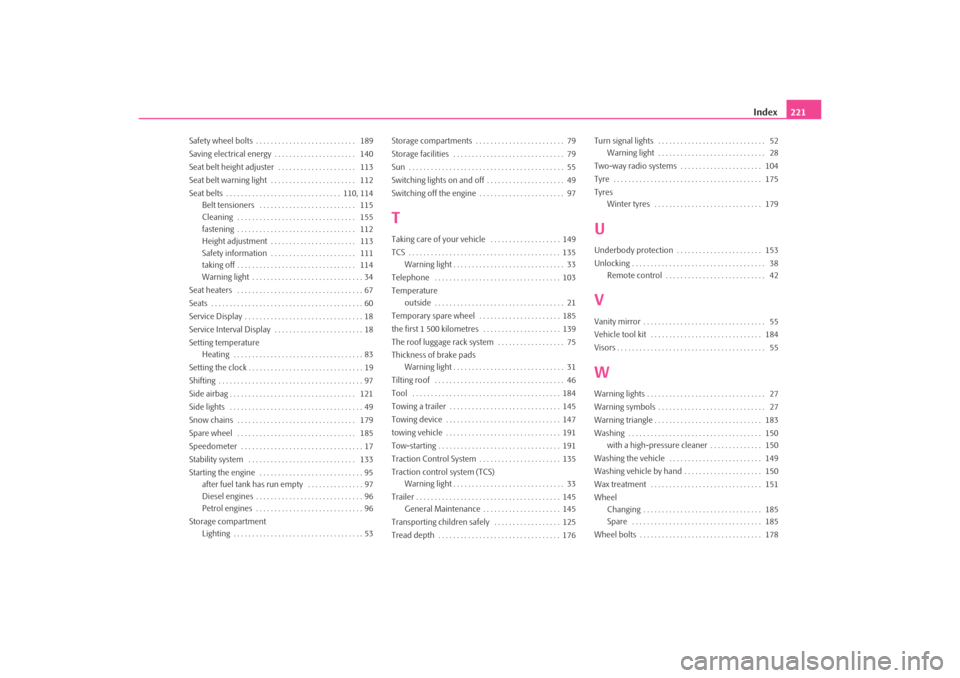
Index221
Safety wheel bolts . . . . . . . . . . . . . . . . . . . . . . . . . . . 189
Saving electrical energy . . . . . . . . . . . . . . . . . . . . . . 140
Seat belt height adjuster . . . . . . . . . . . . . . . . . . . . . 113
Seat belt warning light . . . . . . . . . . . . . . . . . . . . . . . 112
Seat belts . . . . . . . . . . . . . . . . . . . . . . . . . . . . . . . 110, 114
Belt tensioners . . . . . . . . . . . . . . . . . . . . . . . . . . 115
Cleaning . . . . . . . . . . . . . . . . . . . . . . . . . . . . . . . . 155
fastening . . . . . . . . . . . . . . . . . . . . . . . . . . . . . . . . 112
Height adjustment . . . . . . . . . . . . . . . . . . . . . . . 113
Safety information . . . . . . . . . . . . . . . . . . . . . . . 111
taking off . . . . . . . . . . . . . . . . . . . . . . . . . . . . . . . . 114
Warning light . . . . . . . . . . . . . . . . . . . . . . . . . . . . . . 34
Seat heaters . . . . . . . . . . . . . . . . . . . . . . . . . . . . . . . . . . 67
Seats . . . . . . . . . . . . . . . . . . . . . . . . . . . . . . . . . . . . . . . . . 60
Service Display . . . . . . . . . . . . . . . . . . . . . . . . . . . . . . . . 18
Service Interval Display . . . . . . . . . . . . . . . . . . . . . . . . 18
Setting temperature Heating . . . . . . . . . . . . . . . . . . . . . . . . . . . . . . . . . . . 83
Setting the clock . . . . . . . . . . . . . . . . . . . . . . . . . . . . . . . 19
Shifting . . . . . . . . . . . . . . . . . . . . . . . . . . . . . . . . . . . . . . . 97
Side airbag . . . . . . . . . . . . . . . . . . . . . . . . . . . . . . . . . . 121
Side lights . . . . . . . . . . . . . . . . . . . . . . . . . . . . . . . . . . . . 49
Snow chains . . . . . . . . . . . . . . . . . . . . . . . . . . . . . . . . 179
Spare wheel . . . . . . . . . . . . . . . . . . . . . . . . . . . . . . . . 185
Speedometer . . . . . . . . . . . . . . . . . . . . . . . . . . . . . . . . . 17
Stability system . . . . . . . . . . . . . . . . . . . . . . . . . . . . . 133
Starting the engine . . . . . . . . . . . . . . . . . . . . . . . . . . . . 95 after fuel tank has run empty . . . . . . . . . . . . . . . 97
Diesel engines . . . . . . . . . . . . . . . . . . . . . . . . . . . . . 96
Petrol engines . . . . . . . . . . . . . . . . . . . . . . . . . . . . . 96
Storage compartment Lighting . . . . . . . . . . . . . . . . . . . . . . . . . . . . . . . . . . . 53 Storage compartments . . . . . . . . . . . . . . . . . . . . . . . . 79
Storage facilities . . . . . . . . . . . . . . . . . . . . . . . . . . . . . . 79
Sun . . . . . . . . . . . . . . . . . . . . . . . . . . . . . . . . . . . . . . . . . . 55
Switching lights on and off . . . . . . . . . . . . . . . . . . . . . 49
Switching off the engine . . . . . . . . . . . . . . . . . . . . . . . 97
TTaking care of your vehicle . . . . . . . . . . . . . . . . . . . 149
TCS . . . . . . . . . . . . . . . . . . . . . . . . . . . . . . . . . . . . . . . . . 135
Warning light . . . . . . . . . . . . . . . . . . . . . . . . . . . . . . 33
Telephone . . . . . . . . . . . . . . . . . . . . . . . . . . . . . . . . . . 103
Temperature outside . . . . . . . . . . . . . . . . . . . . . . . . . . . . . . . . . . . 21
Temporary spare wheel . . . . . . . . . . . . . . . . . . . . . . 185
the first 1 500 kilometres . . . . . . . . . . . . . . . . . . . . . 139
The roof luggage rack system . . . . . . . . . . . . . . . . . . 75
Thickness of brake pads Warning light . . . . . . . . . . . . . . . . . . . . . . . . . . . . . . 31
Tilting roof . . . . . . . . . . . . . . . . . . . . . . . . . . . . . . . . . . . 46
Tool . . . . . . . . . . . . . . . . . . . . . . . . . . . . . . . . . . . . . . . . 184
Towing a trailer . . . . . . . . . . . . . . . . . . . . . . . . . . . . . . 145
Towing device . . . . . . . . . . . . . . . . . . . . . . . . . . . . . . . 147
towing vehicle . . . . . . . . . . . . . . . . . . . . . . . . . . . . . . . 191
Tow-starting . . . . . . . . . . . . . . . . . . . . . . . . . . . . . . . . . 191
Traction Control System . . . . . . . . . . . . . . . . . . . . . . 135
Traction control system (TCS) Warning light . . . . . . . . . . . . . . . . . . . . . . . . . . . . . . 33
Trailer . . . . . . . . . . . . . . . . . . . . . . . . . . . . . . . . . . . . . . . 145 General Maintenance . . . . . . . . . . . . . . . . . . . . . 145
Transporting children safely . . . . . . . . . . . . . . . . . . 125
Tread depth . . . . . . . . . . . . . . . . . . . . . . . . . . . . . . . . . 176 Turn signal lights . . . . . . . . . . . . . . . . . . . . . . . . . . . . . 52
Warning light . . . . . . . . . . . . . . . . . . . . . . . . . . . . . 28
Two-way radio systems . . . . . . . . . . . . . . . . . . . . . . 104
Tyre . . . . . . . . . . . . . . . . . . . . . . . . . . . . . . . . . . . . . . . . 175
Tyres Winter tyres . . . . . . . . . . . . . . . . . . . . . . . . . . . . . 179
UUnderbody protection . . . . . . . . . . . . . . . . . . . . . . . 153
Unlocking . . . . . . . . . . . . . . . . . . . . . . . . . . . . . . . . . . . . 38Remote control . . . . . . . . . . . . . . . . . . . . . . . . . . . 42VVanity mirror . . . . . . . . . . . . . . . . . . . . . . . . . . . . . . . . . 55
Vehicle tool kit . . . . . . . . . . . . . . . . . . . . . . . . . . . . . . 184
Visors . . . . . . . . . . . . . . . . . . . . . . . . . . . . . . . . . . . . . . . . 55WWarning lights . . . . . . . . . . . . . . . . . . . . . . . . . . . . . . . . 27
Warning symbols . . . . . . . . . . . . . . . . . . . . . . . . . . . . . 27
Warning triangle . . . . . . . . . . . . . . . . . . . . . . . . . . . . . 183
Washing . . . . . . . . . . . . . . . . . . . . . . . . . . . . . . . . . . . . 150with a high-pressure cleaner . . . . . . . . . . . . . . 150
Washing the vehicle . . . . . . . . . . . . . . . . . . . . . . . . . 149
Washing vehicle by hand . . . . . . . . . . . . . . . . . . . . . 150
Wax treatment . . . . . . . . . . . . . . . . . . . . . . . . . . . . . . 151
Wheel Changing . . . . . . . . . . . . . . . . . . . . . . . . . . . . . . . . 185
Spare . . . . . . . . . . . . . . . . . . . . . . . . . . . . . . . . . . . 185
Wheel bolts . . . . . . . . . . . . . . . . . . . . . . . . . . . . . . . . . 178
s2ig.book Page 221 Monday, November 10, 2008 11:20 AM
Page 223 of 226
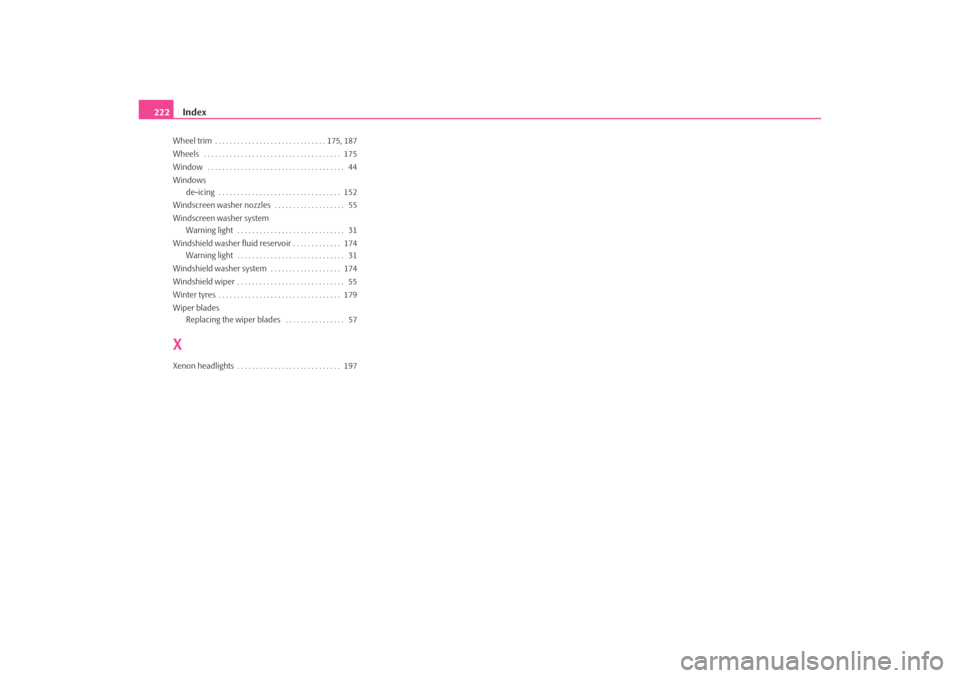
Index
222Wheel trim . . . . . . . . . . . . . . . . . . . . . . . . . . . . . . 175, 187
Wheels . . . . . . . . . . . . . . . . . . . . . . . . . . . . . . . . . . . . . 175
Window . . . . . . . . . . . . . . . . . . . . . . . . . . . . . . . . . . . . . 44
Windows
de-icing . . . . . . . . . . . . . . . . . . . . . . . . . . . . . . . . . 152
Windscreen washer nozzles . . . . . . . . . . . . . . . . . . . 55
Windscreen washer system Warning light . . . . . . . . . . . . . . . . . . . . . . . . . . . . . 31
Windshield washer fluid reservoir . . . . . . . . . . . . . 174 Warning light . . . . . . . . . . . . . . . . . . . . . . . . . . . . . 31
Windshield washer system . . . . . . . . . . . . . . . . . . . 174
Windshield wiper . . . . . . . . . . . . . . . . . . . . . . . . . . . . . 55
Winter tyres . . . . . . . . . . . . . . . . . . . . . . . . . . . . . . . . . 179
Wiper blades Replacing the wiper blades . . . . . . . . . . . . . . . . 57XXenon headlights . . . . . . . . . . . . . . . . . . . . . . . . . . . . 197s2ig.book Page 222 Monday, November 10, 2008 11:20 AM